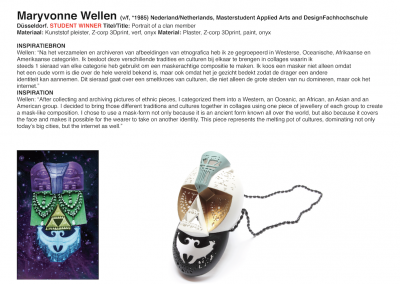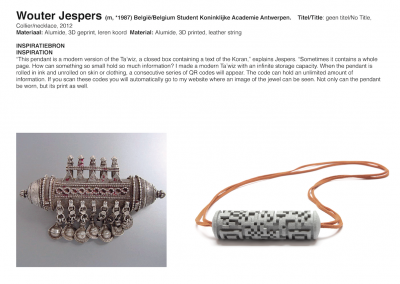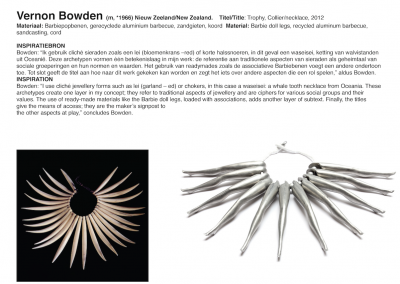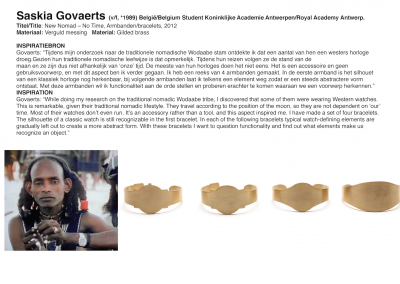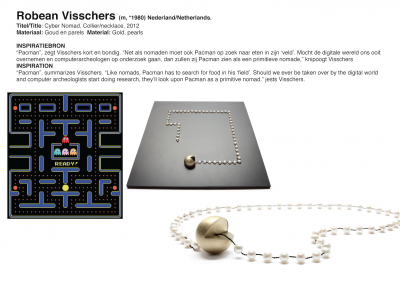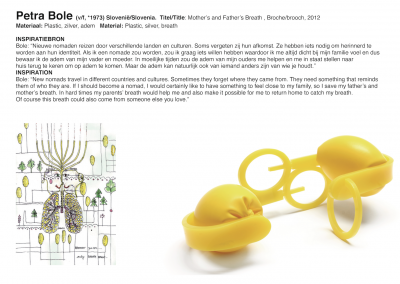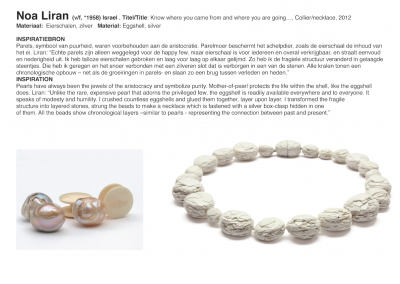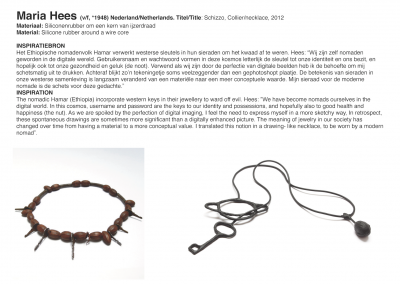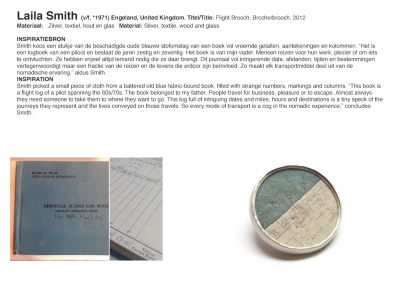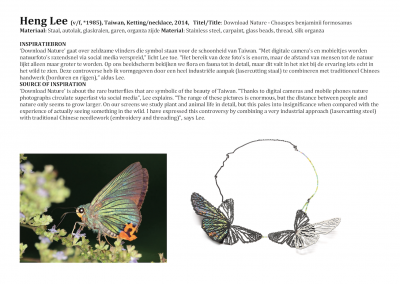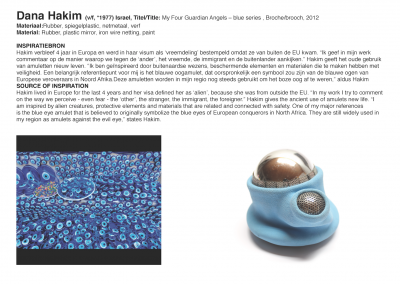2012 New Nomads
Something feminine may be ascribed to many pieces of jewellery which were submitted and many are compositions of fragments. However, among the winning designs there are some explicitly masculine pieces. They are striking because their forms are honest, direct, powerful and basic; clear statements, each one of them.
It would have been hard to come up with a more topical theme than ‘New Nomads’. Great masses of people flee from natural disasters, wars and the financial crisis in Europe. Careers are becoming more and more international, holidays take us further afield than ever before. We choose our own spiritual road, so there is also an inner journey. Throughout history people have carried their valuables with them on their bodies – when they are fleeing or moving or are on a quest for a better future or a better ‘I’. As is still the case in nomadic tribes today, jewellery stands for economic and social status.
BRIDGE
The biennial international design contest for jewellery designers builds a bridge between artists and browsers/buyers, and between tradition and the present. For each edition of NTJ a theme is selected, based on historic (and disappearing) jewellery traditions. Participants are challenged to find new, contemporary forms of expression for old symbol bearers.
The exhibition of NTJ shows not only the entries of the designers, but also their source of inspiration and their motivation. This unique approach tells us a lot about the artist, the original piece of jewellery, its history and the new modern form. In this way NTJ bridges past and present and each theme is the ‘bridge’.
A professional jury selects the designs for the exhibition which will have its opening night at SIERAAD Art Fair. At the same time the names of the winners will be announced. After the fair NTJ will travel at home and abroad. Next stop for NTJ12: New Nomads will be the Museum of Modern Art Arnhem from 24 November 2012 to 27 January 2013.
The jury is impressed by the high level of the entries, from which the selection for the exhibition was made. What is striking is the extent to which the jewellery bears relevance to the theme. The entries take a stand and comment on developments like globalization and digitalization. It is remarkable that to this end in many cases very personal stories, family histories and local traditions are brought to bear. “The result is a kaleidoscopic but coherent exposition”, according to the jury. Both the choice of a theme for NTJ and the selection for the exhibition are in the hands of an international, professional jury (in random order):
Eveline Holsappel, curator contemporary jewellery design, Museum Moderne Kunst Arnhem,
Marjan Unger, Doctor contemporary jewellery design Leiden University, publicist, curator.
Theo Smeets, jewellery artist and professor jewellery and object design, Fachhochschule Trier (Germany)
James Beighton, curator Middlesbrough Institute of Modern Art (UK)
Herman Hermsen, jewellery artist, designer and teacher art academy, Düsseldorf (Germany)
Chequita Nahar, Head of the department product design and jewellery design, art academy Maastricht.
Astrid Berens, director SIERAAD Art Fair
Winners
By means of light reflection the three coloured hearts are mirrored and magnified in the reflecting golden saucers. “A fun brooch”, according to the jury. “Among all the other entries this brooch stands out. Unassuming, yet unexpected.” The coloured hearts are not fixed, but come alive and start quivering when you move. The brooch refers to flowers, a rainbow and a kaleidoscope. “There is a lot to be enjoyed in this piece of jewellery. It has something energetic and optimistic. The brooch is proof that once again jewellery is allowed to dazzle you”. The jury regrets that gold is so little used. Sang Hee Park justifies its right of existence and hopes he will make a gold version in the near future.
Patricia Dominques, Portugal. Reconstructed ivory, foam, steel, silver.
The brooch consists of a white and a brown part interlaced with fault lines, veins or fissures. It is composed of bits and pieces glued together. “A subdued architectonic work. The lineation is quite intriguing. It is a robust, but at the same time very sensitive work. The creation is nomadic in time, because you keep building step by step until the point of completion is there”.
Juliane Kessler, Germany. “Traffic Sign”, brooch. Aluminium and steel.
“At first sight this looks like a simple design, but when you look longer, you find perfection”, says the jury. The brooch is made from a recycled traffic sign. That sounds easy, but nothing could be farther from the truth. In combination with her motivation and the symbolism of the turtle, the work is intrinsically strong as well. The grand finale is the back: there the steel needle is skilfully clamped in the kink of the brooch. An equally brilliant as elegant solution. “This brooch is another good example of an entirely individual piece of jewellery”.
On the underside the chips are woven together with yarn to form a flexible square mat. One side is decorated, the other is gold. The yarn remains visible as a reference to the contacts that are made using chips. “This necklace is only done justice when it is worn”, says the jury. “In several, playful ways things are hidden and things are made visible, and at all times only one side of the necklace is visible. The decorated side refers to the issues of the day: time, communication, money. The golden side (the back of the chips) calls up associations of illustrious civilizations, like the Egypt of the pharaohs and the Mayas. At the same time the chips contain information not visible to the naked eye. This necklace is a bridge in time”.
Maryvonne Wellen, Holland/Germany. Necklace of onyx beads and pendant of synthetic plaster, Z.corp 3D printed and painted.
The jury is impressed by the technique as well as the design. “We all thought it meant different things. Wellen has taken the still young technology of 3D printing to a new level. The pendant is reminiscent of a mask, but has been composed so carefully that you could discover ten masks in it. The complete mask, which has an elementary oval shape, as well as the individual parts tell a story. This piece bridges ethnography and the space age”.
